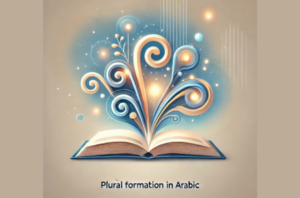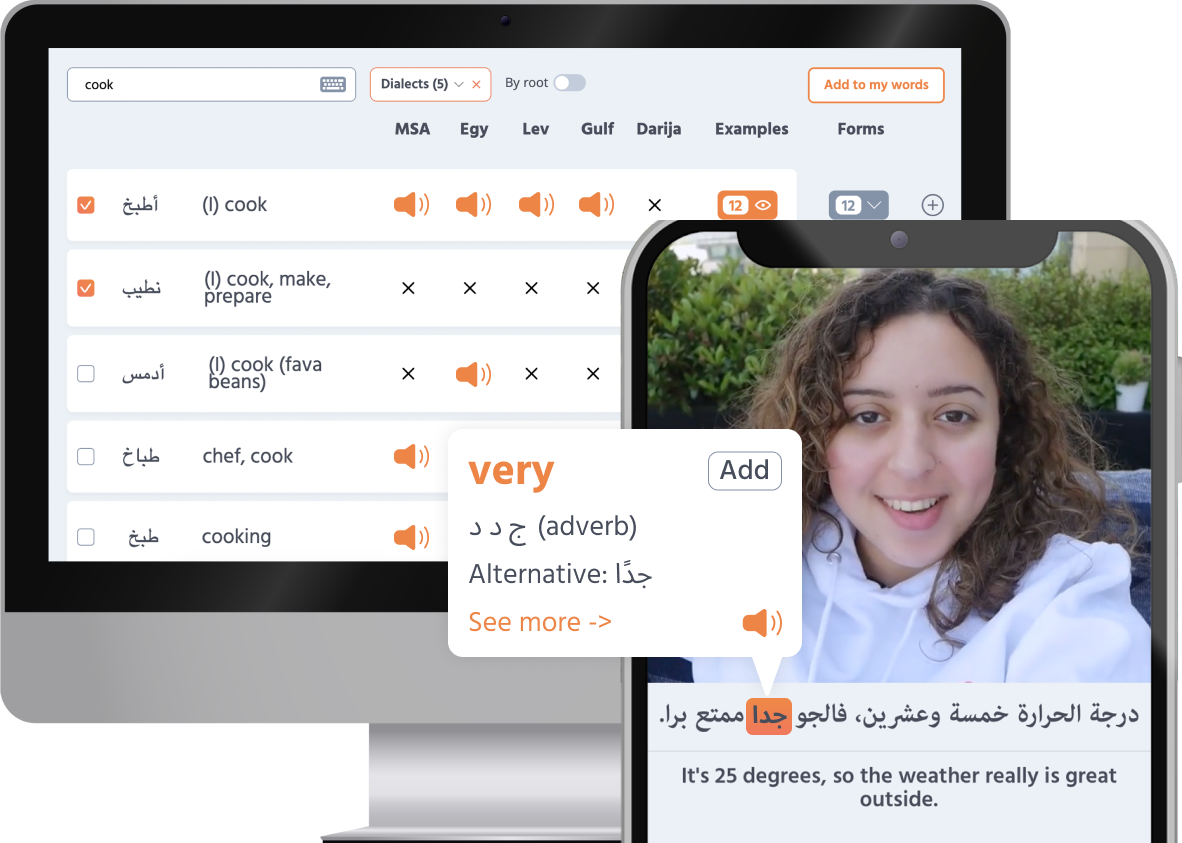Colors are more than just visual experiences; they’re a key part of our language and culture. Learning how to describe colors in Arabic can open up new ways of expressing yourself and understanding others. From describing the azure skies of Morocco to the vibrant spices in a bustling Egyptian market, colors bring conversations to life. So, let’s embark on this colorful adventure and learn how to paint our Arabic vocabulary with the hues of everyday life!
Common color vocabulary in Arabic Let’s begin with the basics: here are the names of colors in Modern Standard Arabic (MSA) and major Arabic dialects such as Levantine (Palestinian , Jordanian , Syrian , Lebanese ), Egyptian , Gulf , and Maghrebi . This includes their masculine singular, feminine singular, and plural forms.
English Standard Palestinian/Jordanian Syrian Lebanese Egyptian Gulf Maghrebi Red masculine feminine broken pl
Blue masculine feminine broken pl
Green masculine feminine broken pl
Yellow masculine feminine broken pl
White masculine feminine broken pl
Black masculine feminine broken pl
Brown masculine feminine broken pl
Orange masculine feminine broken pl
Pink masculine feminine broken pl
Purple masculine feminine broken pl
مُوف
Gray masculine feminine broken pl
Examples
A clip about colors in Levantine Arabic from real world videos on Playaling. From عامية عربية. A clip about colors in Maghrebi Arabic. From Alwan a Lebanese TV show for kids . Grammatical rules regarding colors in Arabic Colors follow specific grammatical rules when used with nouns. Here’s a breakdown:
Singular nouns (animate and inanimate)
Masculine singular : When describing a singular masculine noun, the color adjective matches the noun in gender and number.
Examples:
القلم الأحمر
(the red pen)الكتاب الأخضر
(the green book)الولد الأبيض
(the white boy)
Feminine singular : When describing a singular feminine noun, the color adjective also matches the noun in gender and number.
Examples:
الزهرة الصفراء
(the yellow flower)السيارة الزرقاء
(the blue car)البنت السوداء
(the black girl)
Plural nouns (inanimate)
Arabic generally treats inanimate plural nouns as feminine singular. So when a color adjective describes an inanimate plural noun, the adjective typically takes the feminine singular form:
Examples :
الأقلام الحمراء
(the red pens)الكتب الخضراء
(the green books)الزهور الصفراء
(the yellow flowers)السيارات الزرقاء
(the blue cars)
Plural nouns (animate)
Arabic generally treats animate plural objects as plural, so adjectives take plural form:
Example:
الأولاد البيض
(the white boys)الهنود الحمر
(Native Americans or literally: “The red Indians”)
Flexibility for spoken Arabic While the rules above usually hold true for Arabic across the board (both MSA and dialects), there’s some flexibility for colloquial Arabic:
Describing plural inanimate objects
Although plural inanimate nouns generally take feminine singular in dialects, it’s possible to see adjectives – including colors – in plural form when describing plural inanimate nouns.
For example, in Levantine:
السيارات الحمرا
or السيارات الحمر
(the red cars)الكتب الزرقا
or الكتب الزرق
(the blue books)الكنبايات الرمادية
or الكنبايات الرماديات
(the gray couches)
For example, in Egyptian:
العربيات الحمرا
(the red cars)الكتب الزرقا
(the blue books)الكنب الرمادي
(the gray couches)
For example, in Gulf:
السيارات الحمرا
(the red cars )الكتب الزرقا
( the blue books )الكنب الرمادي
( the gray couches)
For example, in Maghrebi:
الطوبيسات الحمرة
(the red buses) or الطُوبيسات الحمرين
الكتوبة الزرقة
(the blue books) or الكُتوبة الزورق
Describing plural animate objects
And while plural animate objects commonly take plural adjectives, there’s some flexibility on this as well.
For example, in Levantine:
البنات البيض
(the white girls)الناس السمر
or الناس السمرا
(the dark-skinned people)الولاد السود
(the black boys)الكلاب البنية
or الكلاب البنيين
(the brown dogs)القطط البرتقانية
or القطط البرتقانيين
(the orange cats)
In Egyptian:
البنات البيضا
or البنات البيض
(the white girls)الناس السمر
(the dark-skinned people)الولاد السود
(the black boys)الكلاب البني
(the brown dogs)القطط البرتقاني
(the orange cats)
In Gulf:
البنات البيض
(the white girls)الناس السمر
(the dark-skinned people)الاولاد السود
(the black boys)الكلاب البنية
(the brown dogs)القطط البرتقالية
(the orange cats)
In Darija:
البنات البويض
(the white girls)الناس السمرين
or الناس السومر
(the dark-skinned people)الولاد الكوحل
(the black boys)الكلاب البنيين
(the brown dogs)القطوط البرتقالية
or القطوط البرتقاليين
(the orange cats)
Color-related idioms and expressions in Arabic Arabic is rich with idiomatic expressions that use colors to convey deeper meanings. These expressions add a layer of cultural depth to the language, making conversations more vivid and expressive. Here are some examples:
Red Red in the Arab world symbolizes both love and danger. It’s a color of passion and energy, but can also represent caution and warning, much like in other cultures.
In Egyptian:
حورّيه العين الحَمرا
or رَحْ فَرْجِيه العيِن الحَمْرَا
(in Levantine) (literally: I’ll show him the red eye): This is used for intimidation, meaning that one won’t put up with any nonsense.
طيزك حمرا
(literally: Your butt is red): This phrase is used in Egypt to respond to a silly question or a comment. Baboons have red butts, so in effect, it implies that someone’s as silly as a monkey. Sometimes all you only need to say is حمرا
to convey the message.
In Levantine:
موت أحمر
(literally: red death): This phrase is used to describe the severity of a certain situation or circumstance. For example, if the weather is unbearably hot, one can say الجو اليوم موت أحمر
. The phrase موت أحمر also means “a violent death”.
لجهنم الحمرا
(literally: To the red hell): This phrase is used to wish someone a bad and painful experience. The color red symbolizes the intense heat and torment traditionally associated with hell in many cultures and religious contexts.
إذا حبيبك ثور البس له أحمر
(literally: If your lover is a bull, wear red for him): This phrase suggests that if someone close to you is stubborn or difficult to deal with, you should know how to provoke them or deal with their temperament effectively. The color red is symbolically used because it is known to provoke bulls, representing the idea of knowing what triggers or affects the person you’re dealing with.
لبست الأحمر وعم تتمختر
(literally: She wore red and strutted around): This phrase describes a woman who is dressed in red and walking with confidence and pride. The color red here symbolizes boldness, attraction, and assertiveness.
عينو حمرا منك
(literally: His eye is red because of you): is a phrase used in the Levant meaning “he’s mad at you”. The red eye symbolizes anger.
In MSA
ليلة حمراء
(literally: a red night): meaning a night of passion.
Cloze Listen exercise from “mixing colors ” in MSA. Don’t miss out on learning and practicing by filling in the blanks with the words you hear on Playaling . Sign up now and enjoy a free trial! Yellow In general, the color yellow holds negative connotations in the Arab world as it is associated with illness; a pale person is often described as having a “yellow face.” It also signifies jealousy. However, being the color of the sun and warmth, it carries some positive connotations as well.
In Levantine & Egyptian:
ضحكة صفرا
in Egyptian or ضحكة صفرا
in Levantine (literally: a yellow laugh): meaning a forced smile or fake laughter.
In Egyptian:
السراية الصفرا
(literally: yellow palace): meaning madhouse, a derisive name for a mental hospital.
جرنان أصفر
(literally: yellow newspaper): This refers to tabloids or newspapers that focus on gossip.
In Levantine:
صفرة الليمون بهجة للعيون
(literally: The yellowness of lemons is a delight for the eyes): This phrase is used in the Levant and highlights the pleasant and cheerful visual impact of the bright yellow color of lemons. Yellow here signifies the uplifting and refreshing effect that the sight of yellow lemons can have, bringing joy and brightness to one’s day. This idiom is typically used to convey how simple, natural things can bring happiness and a sense of delight.
كنتنا صفرا وإجاها وحام
(Our daughter-in-law was pale, and now she has pregnancy cravings): This is a common saying in the Levant used to describe a woman’s frailty and laziness, often said by her husband’s family, like his mother and sisters, due to typically tense relations. They say their daughter-in-law was already pale, and now with pregnancy cravings, she’s even paler and lazier. This saying is used not just for pregnancy, but for any situation that might give her an excuse to be lazy or tired, like illness, being busy, or anything else.
Green Green is considered a sacred color in Islam. It symbolizes paradise, renewal, and hope. Sufis usually wear green turbans or scarves. In a verse in the Quran, people will wear green clothes in heaven: يُحَلَّوْنَ فِيهَا مِنْ أَسَاوِرَ مِن ذَهَبٍ وَيَلْبَسُونَ ثِيَابًا خُضْرًا مِن سُندُسٍ وَإِسْتَبْرَقٍ
(They will be adorned therein with bracelets of gold and will wear green garments of fine silk and brocade). Green is the color mostly used in mosques. The dome built above Prophet Muhammed’s tomb in Medina is green.
In MSA:
أتى على الأخضر واليابس
(literally: He destroyed the green and the arid): This phrase is used to describe a situation where everything, both valuable and worthless, is destroyed without distinction. This idiom highlights the indiscriminate nature of such actions, where the consequences are far-reaching and affect all aspects involved.
In Levantine:
النعنع خضرا متل العوجا
(literally: Mint is green like chaos): This phrase is used in the Levant region, particularly in Palestine. It contrasts the refreshing, calming green of mint with the chaos and disorder suggested by the word العوجا
. The idiom highlights the paradox of finding calmness or normalcy within a state of disorder or confusion.
بياكل الأخضر واليابس
(literally: He eats the green and the arid): is a popular saying describing someone who loves food and is very greedy, not leaving anything uneaten, whether it’s good or not.
نفسو خضرا
(literally: His desire or appetite is green): is a popular saying in the Levant that indicates a person’s strong sexual desire and attraction to the opposite sex.
From a show called Arabic with Dima (بالعربية مع ديمة). Pink The color pink in the Arab world symbolizes femininity, and it is commonly used for girls in clothing, furniture, and more. Conversely, it is uncommon and unusual among men. Additionally, the color pink signifies joy and happiness. Below are some phrases associated with this color and commonly used in the Arab world.
In Maghrebi:
وردية الدنيا
(literally: The world is rosy): This phrase indicates that things are looking positive.
In Egyptian:
الحياة بقى لونها بمبي
(literally: Life’s color became pinky): A verse from a famous upbeat Egyptian song from the seventies. In the video below, someone talks about drama queens who can find sadness even if life is “pinky” or perfect.
From Jordanian show. In Levantine:
الزهر بيقهر قهر
(literally: Pink causes great grief): A popular saying expresses how the color pink, when worn, can make others feel envious of the person’s beauty.
White Same as with other cultures, white is considered the color of purity in the Arab world.
In Egyptian:
نهارك أبيض
(literally: May your day be white): Used in Egypt to wish someone a good day.
An Egyptian street vendor wishes someone a good day. From سكتش 2.
يا خبر أبيض
(literally: What white news!): A euphemism for يا خبر إسود (What black news!)
قلبه زي البفتة البيضا
(literally: His heart is like white calico fabric): Used to refer to a good-hearted person.
شيك على بياض
(literally: bank check ‘written’ on whiteness): meaning a blank check
ما عندوش لا أبيض ولا إسود
(literally: He doesn’t have neither black nor white): He is penniless.
In Levantine & Egyptian:
قلبه أبيض
in Levantine and in Egyptian or
in Gulf (literally: His heart is white): Used to describe someone who is good-hearted and pure.
القرش الأبيض ينفع في اليوم الإسود
in Egyptian or خَبِّي قرشك الأبيض لَيَوْمَك الأَسْوَد
in Levantine (literally: A white penny is useful on a black day). A proverb meaning that even a little money can help when times are bad.
In MSA & Levantine & Egyptian:
كذبة بيضاء
in MSA or كذبة بيضا
in Levantine (literally: white lie): A minor or harmless lie told to avoid hurting someone’s feelings, to avoid a minor inconvenience, or to be polite.
سلاح أبيض
in MSA or سلاح أبيض
in Egyptian (literally: white weapon): any blade used as a weapon.
In MSA
السم الأبيض
(literally: the white poison): heroin
ثورة بيضاء
(literally: white revolution): peaceful, bloodless revolution.
بياض النهار
(literally: whiteness of day): daylight
In MSA & Levantine & Gulf
بيّض الله وجهك
in MSA or الله يبيِّض وجهك
in Levantine or
in Gulf (literally: May God whiten your face): meaning may God honor you.
In Levantine:
صفحة بيضا
(literally: white page): Turning a new page, signifying leaving the past behind and moving forward with new intentions or actions.
صحيفته بيضا
(literally: His paper or page is white): He has a clean slate or record.
بيبيّض الوج
(literally: It whitens one’s face): meaning it makes someone proud or makes him look good
بياض الوجه
(literally: whiteness of the face): fine character or good reputation
Blue In the Arab world, blue is often associated with the supernatural. It is the color of the traditional evil eye amulets. It also has negative connotations, despite being considered the color of calm and tranquility all over the world. One theory suggests this might be because of its association with the blue eyes of the European invaders.
In Egyptian:
هباب أزرق
(literally: blue soot): meaning horrible stuff
عَضْمة زَرْقا
(literally: blue bone): an abusive epithet for an Egyptian Copt. This goes back to the Fatimid era when Christians were forced to wear a heavy cross hanged by a rope around their necks, which bruised their necks and were then therefore called “a blue bone”.
نابُه أَزْرَق
(literally: He has a blue canine tooth): meaning he is deceitful and cunning.
حاطلَّع البلا الأزرق على جتّته
(literally: I’ll bring out the blue calamity upon his corpse): said as a threat, meaning I’ll show him.
اِنْتَ حَتِشْتَغَلْ لي فِ الأَزْرَق
(literally: Are you going to work or operate in the blue “zone”?): meaning are you trying to play dirty with me?
الجن الأزرق مايعرفش طريقه
(literally: Even the blue jinn wouldn’t know its path): This phrase is used to describe something that is well hidden, that even the blue jinn (the most mischievous jinn) wouldn’t be able to find it.
العفاريت الزرق بتتنطط في عينيه
(literally: The blue demons are jumping in his eyes): meaning he is furious.
In Levantine:
عضمه أزرق
(literally: His bone is blue): This phrase is used to describe someone as mean or spiteful.
متل الجن الأزرق
(literally: like the blue jinn): This phrase is used to describe someone who appears suddenly and unexpectedly, much like a mischievous or unpredictable spirit.
Black Of course, black is the color of death and mourning. It has negative connotations in Arab culture , such as sadness, grief, and misfortune. A lot of the expressions here are basically the opposites of the ones with “white”.
In Egyptian:
سنة سودا
(literally: a black year): an unfortunate year
يا خبر اِسود
(literally: What black news!): Such bad news!
In Levantine:
اسودت الدنيا بعيوني
(literally: The world turned black in my eyes): This phrase expresses deep sadness and loss of hope in life.
يوم أسود
(literally: a black day): an unlucky day.
In Levantine & Egyptian & MSA & Gulf:
قلبه أسود
in Levantine or
in Egyptian or
in MSA or
in Gulf (literally: His heart is black): He is an unkind person, his heart is full of spite.
In Maghrebi:
قلبه أكحل
(literally: His heart is black): This is in Darija. أكحل is another word for أسود (black).
In a Jordanian mini-series (بث بياخة.), someone receives bad news while trying to relax on Friday, his day off. In Levantine:
الأسود والأحمر
(literally: the black and the red): meaning all mankind
بيسوّد الوجه
(literally: He blackens the face): meaning he brings shame.
طلعنا منها بسواد الوجه
(literally: We came out of it with blackness of the face): We came out of it looking very bad.
يا ويلهم ويا سواد ليلهم
(literally: Woe unto them and woe unto the blackness of their night): It means that they’re in deep trouble.
In MSA:
سوّد الله وجهه
(In MSA) or سوّد الله وجهه
(in Gulf) or الله يسود وجهو
(in Levantine) (literally: May God blacken his face): meaning may God shame him.
Despite the above, black eyes are seen as a sign of beauty in the Arab, and the phrase سواد العين (blackness of the eye, the iris) is used in various contexts, such as love and flirtation:
سواد العين
: Saying someone is the سواد العين (in Levantine) means they are very dear and important to us, just like our eye is.
Syrian singer swears by the blackness of her lover’s eyes, or his pupils, because they’re so precious to her.
عشان سواد عيونك
(in Levantine and Egyptian) (literally: for the blackness of your eyes): when we say we’ll do something “for the blackness of your eyes,” it means we’ll do it out of love for you without expecting anything in return.
Indigo The color indigo is a dark blue, and was extracted from the indigo plant نيلة
that grew along the banks of the Nile النيل
. The plant was used in funerals in Ancient Egypt, which explains the negative connotations associated with it. The following expressions are Egyptian and some are used in Palestine and Jordan as well.
In Egyptian:
نهار إسود ومنيّل
(literally: a black and indigo day): an awful day
An Egyptian woman expresses her shock and distress by saying يا نهار أسود ومنيِّل after hearing that the police have found out about their scams.
يا دي النِيلة
(literally: O indigo!): What a mess! What a disaster!
جتك نيلة
(literally: May indigo come to you!): meaning “Go to hell!”
اتنيّل بِستين نِيلة
(literally: Get dyed with sixty indigos!): intensified. The number sixty is especially used for amplification purposes.
اتنيّلت
(literally: I got dyed with indigo): I got into a mess or screwed up
لا رحت ولا اتنيّلت
(literally: I didn’t go or get dyed with indigo): used as an intensifier
ما تتنيّل وتاكل
(literally: Why don’t you get dyed with indigo and eat!): used as an intensifier.
In Egyptian & Levantine (Palestine and Jordan):
اتنيّل
(literally: Get dyed with indigo!): meaning go screw yourself, go to hell, or get lost.
منيّل
(literally: indigo-colored): meaning bad, awful, lousy, crappy.
Oh, and by the way… If learning Arabic at your own pace, with fun, real-world videos sounds like your style, then Playaling could be exactly what you’re looking for!
With Playaling, you’ll dive into any major Arabic dialect or MSA. Our diverse range of videos has it all—from everyday conversations and cultural moments to music videos, TV and movie clips, influencer content, news broadcasts, and inspiring talks.
Our interactive captions let you tap any word for instant translations, context, and audio. So, real Arabic content becomes accessible with just a click. Miss something? No problem—rewind and listen as often as you need, or hover over subtitles for quick definitions.
Spot a word you want to learn? Save it to your personalized word set, or dive into curated sets for focused practice and easy review.
Interactive exercises let you dive in and practice what you’ve learned.
Need to look something up? The Audio Dictionary has you covered with clear human pronunciations and real world examples.
It’s a learning experience that keeps you engaged, bringing authentic, real-world Arabic closer to you every step of the way.
Give it a try!









